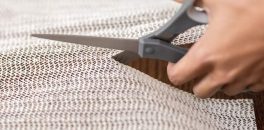Safest Driving Position [And Comfy for Long Trips]

Getting seated inside a car is very easy right, or is it? A good driving position can make an ordinary car exhilarating to drive just as much as a bad position can almost spoil driving a good car. A car needs to let you sit as close as possible to the road. Sitting super low is great for the center of gravity, but it can be difficult to position your car and attack a good bit of the road.
With a proper view out, over the top of hedges and walls, you are not just safer in your car but also faster. With high sitting car positions, you are able to overtake and bail out in time, you spot the road imperfections quicker while setting your trajectory up to miss any obstacles ahead. As with walking, driving requires both sight and balance.
The general contribution from our eyes is the battleground of the debate about seating position. The question is whether to sit high for a bigger view and better three-dimensional view? Or to sit low to sense gravitational forces more accurately?
When it comes to posture, you need to be trying to drive a car that is a suitable size for you. For example, if you are 7ft a supermini will not allow you to achieve a reasonable posture. Even though most cars are not designed for the correct sitting position many now offer a vast array of adjustments for both the seats and the steering wheel.
To find your ideal position, you should start with your seat in the wrong position and then adjust it from there. Adjust the seat height up until your hips are at least as high as your knees. Make sure you can still see the road and the instruments. Not to be so high up that you have to bend your head down or to the side in order to see.
If you are too low even after adjusting to the maximum height, try adding a cushion or wedge to the seat. Cushions also decrease vibrations from the road which have been shown to cause injuries. Ensure the back of your knees does not touch the car seat bottom. This is bad for your knees and circulation. There should be at least a two-finger gap between the gap of your knee and the seat.
Your seating position should be in such a way that you can completely reach all the foot pedals without your back moving away from the back of the seat. Having your knees too straight can cause knee pain, have a small bend of at least 20-30 degrees.
Let’s not forget your feet, which should always be relaxed with your heels on the floor while balls are able to press the pedals. The right foot should be able to move freely between the accelerator and the brake pedal while the left foot is resting on the footrest. This increases support to both the pelvis and the back.
The availability of seat belt pre-tensioners stops you from slipping under the seat belt. Thus, position the seat bottom horizontally whenever possible. In order to decrease the pressure on the discs of your lower back, raise the inclination of the seat back to an angle of 100-110 degrees.
Most cars have lumbar support which is often both height and depth adjustable. Make it in the curve of your lower back. The lowest edge of the support should be placed at your belt line or on top of the pelvis. Use a small rolled-out towel if you don’t have lumbar support. Especially if you are traveling for a long distance.
The towel can be rolled less or more to create varying sizes of curves until you find the right one for you. This method is cheap, easy, and massively variable but it is not a long-term solution. This is mainly because the towel falls away every time you leave and it will continue to squash flatter and flatter over time. Or for a more permanent solution go for the lumbar cushions which come in various shapes, sizes, and designs.
Ideally, the back of your car seat should reach the height of your shoulders. Most car seats come with adjustable headrests. You should be able to adjust both the height of the headrest and the front-back position. It should always rest in the middle of the head.
Once you are sitting correctly in your seat, adjust your mirrors to give optimal rear visibility. This is vital for both your posture and your driving performance. A good tip to check your posture would be-If you look in an adjusted mirror and you no longer have optimal rear visibility then your posture has been compromised. Just sit up.
Most cars now come with three-point seatbelts, which have been proven to reduce the risk of injury in case of an accident. Especially since they are adjustable. Always reach for the seatbelt across with the opposite arm and turn your body not your shoulder. Also, you should consider the seatbelt going over your pelvis rather than your abdomen.
While the upper portion of the seat belt should pass over the clavicle and the sternum rather than the neck, the shoulder, and under the arm. This helps prevent twisting in the event of an impact.
In cars fitted with airbags in the steering wheel, a distance of about 10-12 inches is required so that they can work optimally. As an added advantage, most steering wheels have the feature of adjustable height and in and out. Thus, you don’t have to adjust your seat back and forth to find a suitable position.
Whenever you are not moving, you should be able to sit with your shoulder blades pressed back into the chair, with a straight arm such that your wrist is able to bend over at the steering wheel at an angle of at least 120 degrees.
Where adjustable, the steering wheel should allow a clear view of the dashboard with your palms just lower than your shoulders. This is normally described in relation to a clock face; you can either use the nine -three or four -seven.
Keep both hands on the wheel as much as possible, as steering with one hand strains one shoulder and causes back problems. It is highly discouraged to hold the steering wheel at the top with one hand. Try to drive a car were reaching for the gear stick allows room for the arm to remain neutral.
While you were younger, I am positive you probably curled yourself up with your head this way and your feet the other way. Not quite the same now as sitting for long hours can make you ache almost as if you run instead of using a luxurious car. So how can you improve your comfort while traveling on long trips?
Instead of using your brakes to get snacks, use them to take walks to stretch your legs. This is to mean you get to bring snacks from home. Almonds and carrots are known to keep the body alert. It not only saves you money but you also get a healthier choice of foods. Even if you are feeling fine, take the time to stretch for even five minutes every three to four hours.
Keep the water supply well-stocked for maximum energy. Although this may call for bathroom breaks you might use them for stretching your legs. It is also good to plan these stops such that they fall into meal times or sight-seeing beautiful sceneries.
The last thing you want on a road trip is your car overheating or your AC giving out. Always take the time to check all your car’s fluids before you start your journey to avoid low coolant surprises.
The repetitive process of chewing gum increases circulation and alertness. You do not need the sugary kind to get the desired effect. A pleasant all-natural pick-me-up that has been shown to reduce fatigue is the energizing scent of peppermint.
On a long trip, bring music that you love to sing to and dance to. Play it loud and with the windows down. Avoid soothing music that may cause you to fall asleep.
Think about the exhaustion before you begin your journey and not after. Get plenty of sleep at least two consecutive nights prior to the trip to build up your energy reserves. As an additional tip, avoid driving between 1-3 pm when the body temperatures are lower and you naturally feel drowsy.
It is always good to have other time-killing diversions for your passengers apart from talking all the way on your long trips. That kind of aggravation can cause fatigue. Humorous podcasts and DVDs can keep the brain active and alert.
In conclusion, driving day to day, you may not notice your bad habits or posture. With the tips I have listed, adjust your posture so that you are not straining hence causing health problems.
Sitting in a car is no different from sitting in an office hence, you should still try to get regular breaks. Driving on the open road is exhilarating, but not when you are sore to the extent you are distracted from good driving habits. Take care of your body by paying attention to how you sit.


![Good Posture for Bassists [Best Posture for Playing Bass]](https://www.goodposturehq.com/wp-content/uploads/thumbs_dir/Good-Posture-for-Bassists-prlo9r28a7kjuccnls4l0ln7wus4y8khcjvamosmhg.jpeg)
![Good Posture When You Draw [How to Get the Best Position]](https://www.goodposturehq.com/wp-content/uploads/thumbs_dir/Good-Posture-When-You-Draw-prlnpziekmihpj280qk0337a867a3d3oaq0qc83nbo.jpeg)
![Driving Posture Support [How to Achieve a Good Driving Position]](https://www.goodposturehq.com/wp-content/uploads/thumbs_dir/Driving-Posture-Support-prlmshjh06nlxtpymr9nq1iw2tbcrp420x0rm7rr2s.jpeg)
